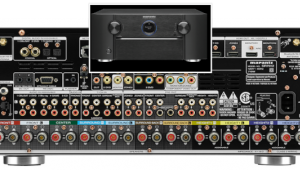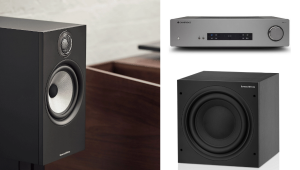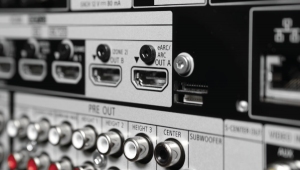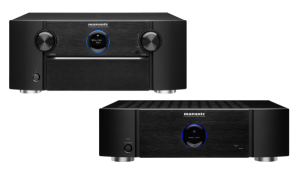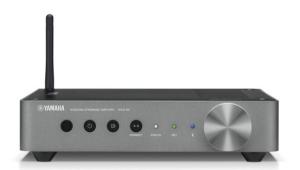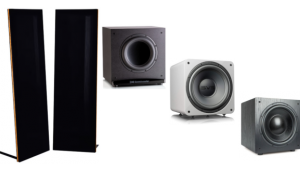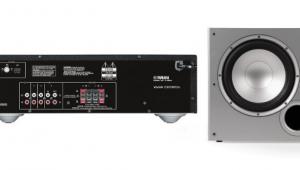Signal Switching, Tactile Transducers, Blu-ray Audio

I am buying a new TV soon, and I'm looking at the Samsung B8000, but on Leo Laporte's radio show, you keep talking about the B8500. Is the 8500 really $500-$1000 better than the 8000? Am I going to notice the difference?
Also, I'm looking for another home-theater receiver—but not a home-theater receiver. I want to use my 5.1 speakers, but I would rather just use an amplifier for the sound. I like the idea of using the TV to switch the video because I can use the picture-in-picture feature.
Finally, my wife and parents can't seem to figure out my Harmony remote; if the TV, receiver, and source (TiVo, Xbox, etc.) get out of sync, they are helpless. Is there a better solution?
Todd Palermo
I do think the 8500 is that much better than the 8000, because the 8500 uses LED backlighting with local dimming, whereas the 8000 uses LED edge lighting with no local dimming. The difference is that the 8500 achieves much better blacks and contrast. Home Theater hasn't reviewed the 8000, but we did review the UN55B8500 here.
You can certainly use the TV as the central video switcher, but not as the central audio switcher, at least not if you want high-quality surround sound. The TV can't easily feed the amps in a 5.1 system, and you won't get the full benefit of Dolby TrueHD or DTS-HD soundtracks. So you need a device to do the audio switching and decoding, which is either an A/V receiver or preamp/processor with multichannel amp.
If you switch the video in the TV and audio in the AVR or pre/pro, things can get complicated. But if PIP is really important to you, and you get HD mainly via terrestrial (over-the-air) broadcast, this may be the only way to go. On the other hand, if you get your HD via satellite or cable, many providers offer PIP functionality in their receiver boxes, so you don't need the TV's PIP, and you can use an AVR or pre/pro for video and audio switching, which is a much better approach.
The Harmony One is the best universal remote I've ever used, and I really like all the Harmony remotes. If the components get out of sync, just hit the Help button and follow the steps in the remote's LCD screen. Just be sure the remote is pointed at the equipment. Even my 84-year-old mother can do it, and she's definitely technically challenged!
A Swift Kick in the Butt
Back in 2003, I was at the E3 video-game show and had the opportunity to visit the Clark Synthesis booth and experience its low-frequency transducers. I am now in a position to install them in my home theater and was wondering what your opinion is. Since it's a fair amount of work to run wires under my floor, I was wondering if you would recommend Clark or another brand, such as Earthquake or ButtKicker. I like that the Clark version since it can be mounted out of sight inside the seating.
Bob Hostetler
I'm the wrong guy to ask this question! I personally hate transducers such as these; they actually make me nauseous. Runco used to use them in their CEDIA demos, and the presenters got to know me and steer me toward one of the few seats without one. I'm sure there are people who love this effect, but I ain't one of them!
Audio Options
What is the difference between multichannel PCM and a raw bitstream output from a Blu-ray player? I recently purchased the Oppo BDP-83 and am trying to figure out if it's better to stream the data to my AVR (which can decode Dolby TrueHD and DTS-HD master Audio) or decode it in the player. Lastly, what is the benefit of using the multichannel analog outputs on the player versus HDMI?
Nathan Daniels
Theoretically, there should be no audible difference between decoding Dolby TrueHD and DTS-HD MA in the player—which then sends multichannel PCM to the AVR via HDMI—versus sending the raw bitstreams and having the AVR decode them. Whatever actual difference you might hear is insignificant in my book. I prefer to have the player do the decoding and send PCM to the AVR so I don't miss the secondary audio—PIP commentaries, menu sounds, etc.—which is sent if the player decodes the audio to PCM but not with the raw bitstream.
I see no real benefit in using the multichannel analog outputs over HDMI unless the AVR doesn't have HDMI capabilities. The analog connection normally bypasses the AVR's bass-management function, and many Blu-ray players don't have this feature. The BDP-83 does provide a basic bass-management function, but it's not as comprehensive as it is in most AVRs. Also, in my opinion, it's a big pain to deal with six or eight analog cables.
If you have a home-theater question, please send it to scott.wilkinson@sorc.com.
